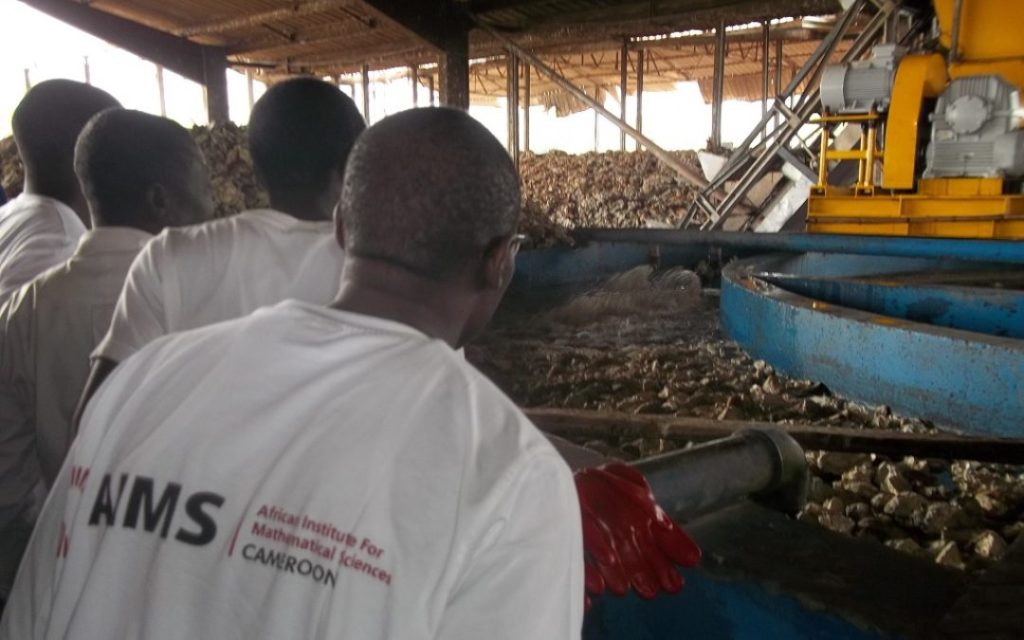THE VISIT ENABLED AIMS CAMEROON STUDENTS TO FIND OUT WHAT MATHEMATICS CAN DO TO OPTIMIZE THE PERFORMANCE OF THE COMPANY
On the 29th of October 2015, the students of AIMS Cameroon visited the Cameroon Development Corporation (CDC). The CDC is an Agro-Industrial complex that mainly grows, processes, markets locally, and export semi-finished rubber, palm oil, palm kernel oil, oil palm, bananas, coconuts and tea. Created in 1947 for the purpose of developing and running plantations of tropical crops in the country, the CDC is one of Cameroon’s major exporters. The parastatal organisation has a current share capital of 35,718,806,000 FCFA. The current General Manager is Mr. Franklin Ngoni Njie. The organization is governed by a Board of Directors presided by a Chairman. The corporation is made up of a workforce of over 22,036 employees, including temporary workers, making it the highest employer after the State of Cameroon.
AIMS Cameroon students visited the Tiko Rubber Factory and the Banana Pack House. At the Tiko Rubber Factory, the students were edified on how rubber is obtained and processed for export. At the Banana Pack House, the students were enlightened on some of the activities involved in all the stages, from planting banana seedlings to harvesting. One of the important aims for banana production, as explained to the students, is to produce bananas that meet up with the GLOBALG.A.P. (Global Good Agricultural Practice) standards, which entails a written guarantee that a production process or product meets laid down standards.
CAN MATHEMATICAL PROBLEM-SOLVING SKILLS IMPROVE PROCESSES IN THE No.1 AGRIBUSINESS COMPANY IN CAMEROON?
During the visits, several factory problems requiring a mathematical solving approach were noticed. As AIMS Cameroon students departed, they promised to look into the problems and provide mathematical solutions. Those problems were as follows;
The main latex-mixing tank and coagulation tanks were not being used because:
- The latex got coagulated inside the pumps due to agitation, as it is pumped from the mixing tank to the coagulation tanks.
- Formic acid needed to be added to the latex as it left the mixing tank but CDC engineers found it difficult to synchronise the rate of flow of acid from the acid tank and the latex from the mixing tank in such a way that the two would mix in the correct proportions.
Consequently, the latex was mixed manually in small quantities and this greatly slowed down production.
On the 15th of January 2016, two AIMS Cameroon students, two tutors, two lecturers, the Academic Director and the Administration and Outreach Officer returned to the CDC Rubber Factory for research on the latex production line concerning the problem that was identified when students visited the factory in October 2015. Two students, William Ngem Ngouana and Edwine Tendong, aided by Dr. Michael Ndjinga from CEA-Saclay in France and lecturer at AIMS Cameroon, Dr. Abdou Njifenjou, lecturer at the University of Douala, the Academic Director Prof. Mama Foupouagnigni, two tutors Daniel Duviol Tcheutia and Jean-Daniel were involved in the study of the problem. The tour of the factory was led by two of CDC’s top executives: the Production Director and the Factory Engineer.
The initial production of latex was processed manually before it was sent to the production line for the final product. If that problem could be identified and solved , then it would increase production and maximize profit.
During the evaluation meeting, the following objectives were highlighted:
- Analyze and predict the property of the different qualites of latex put together. See if it matters to select the types of latex and put them together for better production.
- Estimate the loss during production in terms of money, manpower and pollution.
- Look into building a ramp to direct the latex into the tank and use a pipe to direct latex from the tank to the processing point.
- Compare the result product with the test product.
- Understand the model of the original process.
- Look at the problem of control (regularization) of the flow rate of latex and acid as much as possible to avoid coagulation.
The solutions later proffered were very vital and well appreciated by the company’s management.

